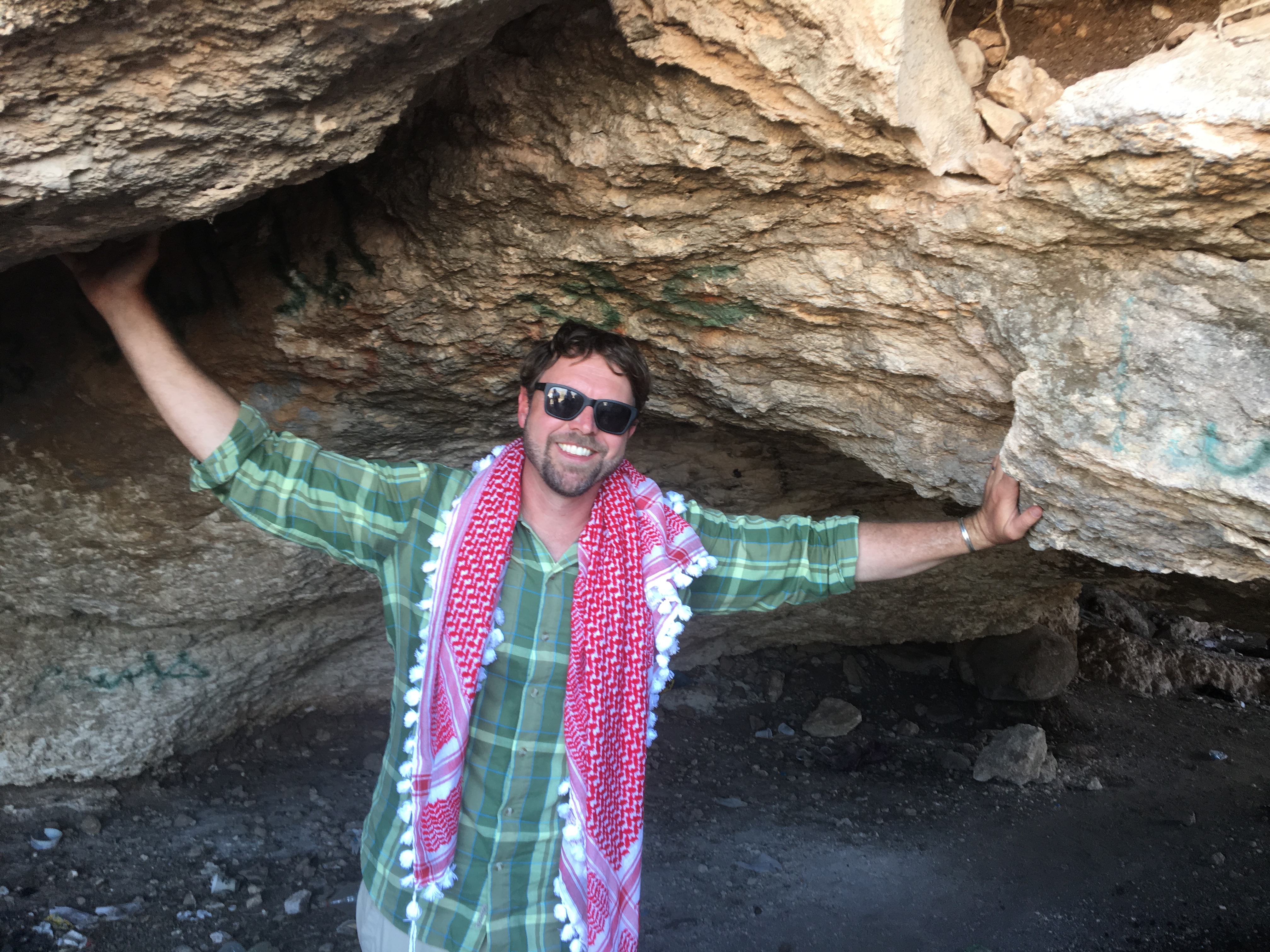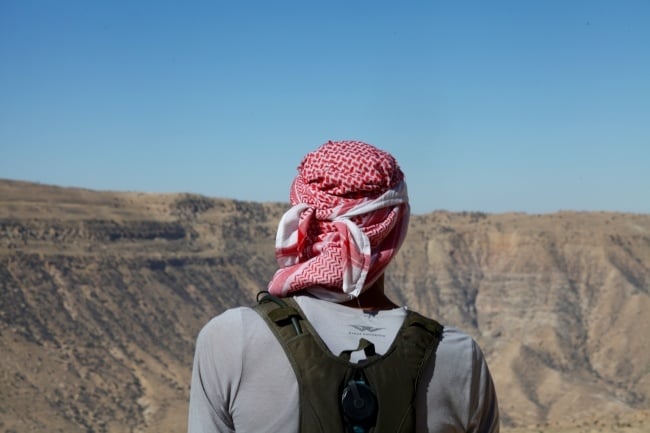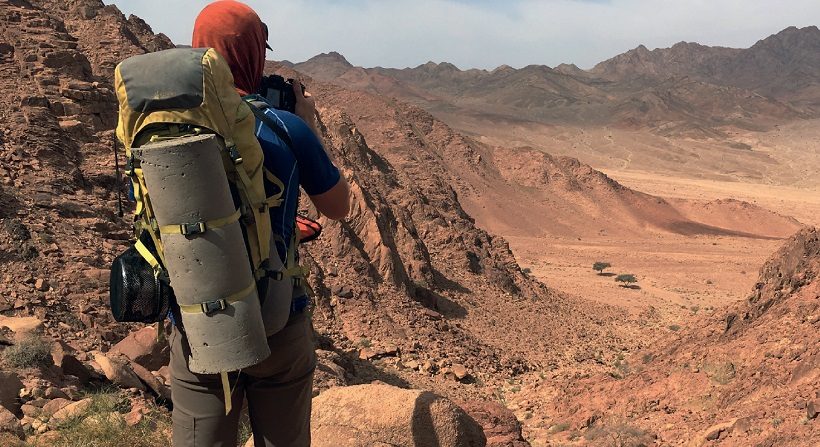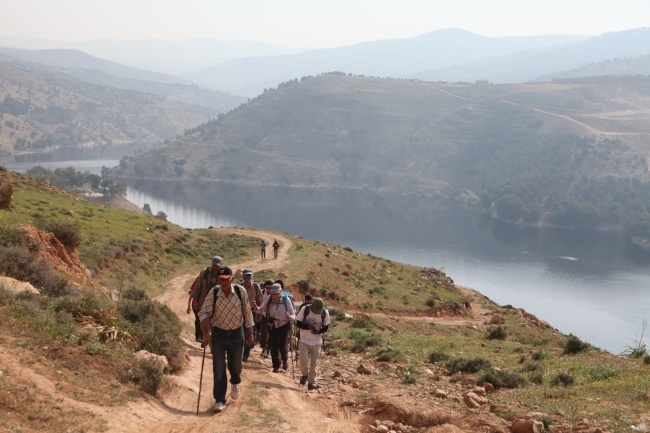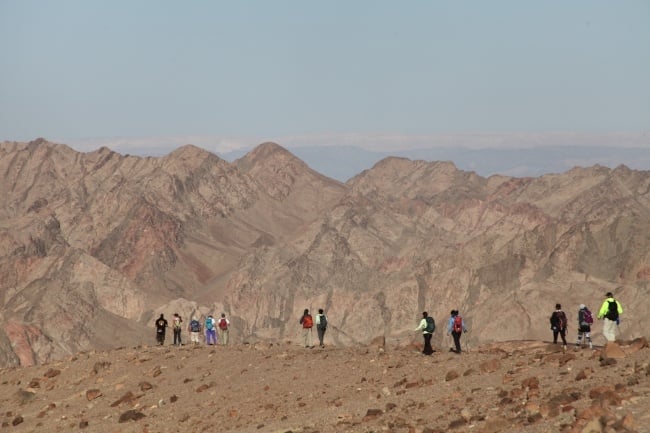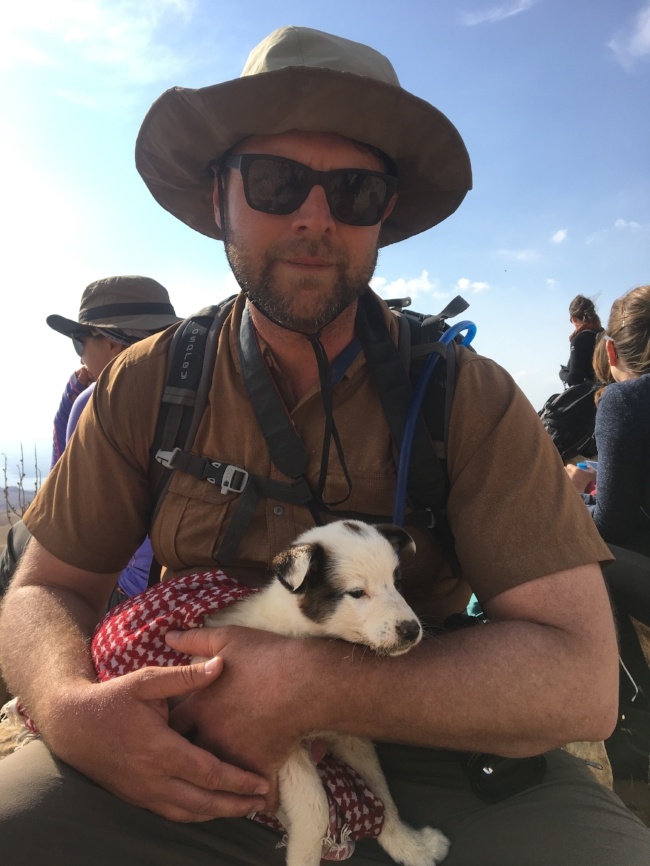
An Unexpected Addition
We heard him before we saw him—the puppy was yelping in the road, running in circles and hopping around, struggling and clearly suffering.
“A puppy!” we cried, quickly scanning the area for any sign of a mama dog, but she was not there, and there were no other puppies around. The constant sound of a lost and lonely puppy howling out in pain was too heartbreaking, and though we had not even hiked our first mile that morning, I dropped to my knees, pulling the small and scrappy dog up into my chest.
He could not have weighed more than a few pounds and was utterly filthy, his dense white fur all matted and brown with gunk. Leaves, branches and bugs all clung to his bony little body and he continued to howl the high-pitched howl of a wounded animal.
The other hikers gathered round and helped hold the dog as the rest of us brushed away the fleas and twisted out the ticks from the puppy’s flesh. These were enormously fat ticks, inflated with blood to the size of giant TicTacs. In the end, we removed over 50 ticks from his little body. Then we tried offering him food and water, but the tiny dog turned up his nose. He only wanted to be held, and so I unwound the kuffiyeh from my own neck and wrapped him up like a fussy baby.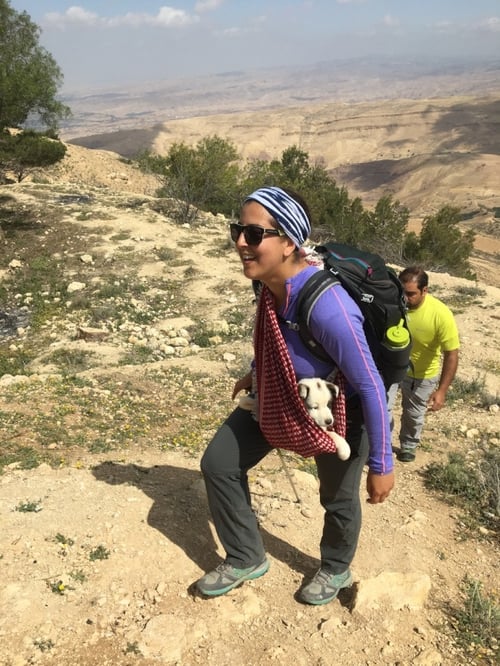
No Hiker - or Puppy - Left Behind
The red-and-white kuffiyeh is almost like a uniform in Jordan—the square cotton cloth is worn around men’s heads and around their necks, to protect from the sun and wind, or to keep warm in the cold. Three weeks into my hike across Jordan, I would go so far as to say my kuffiyeh is the most useful piece of gear I have—and now I can add puppy papoose to the never-ending list of “Things You Can Do With a Kuffiyeh”.
Folded over into a triangle and tied up in a knot, the cloth made the perfect sling for our pint-size friend, so that our fellow hiker Muna was able to carry the puppy hands-free, climbing up the steep mountainside, while the calm puppy now swung gently near her waist.
“But what do we name him?” asked Ziatuna, who is Scottish and actually named Olivia, but ziatun means olive in Arabic, so that’s what we call her.
“Musa?” I suggested, offering the Arabic name for Moses, since at that very moment we were walking in the footsteps of Moses, hiking up to the top of Mount Nebo, near the place where some believe Moses himself is buried. Our group discussed the pros and cons of naming a dog “Musa”, along with the poetic Arabic words that we could call him, such as “white” and “pretty”, until I blurted out, “How about Nebo—since we found him on Mount Nebo?”
It was unanimous, so that by the time Muna had summited Mount Nebo with her sleeping puppy, we had named the dog “Nebo”. His little head rocking in slumber as Muna walked towards us.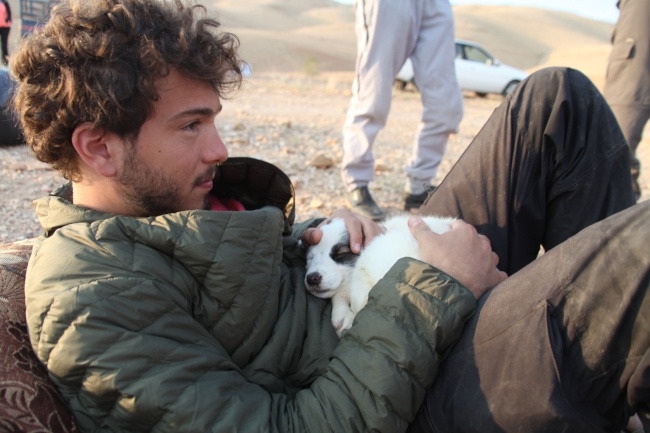
"Can Baba take Nebo for a bit?” asked Muna, handing me the bundle of warmth. While the others visited the new Franciscan church built over the beautiful ruins and byzantine mosaics of the original church, I gave Nebo a bath. I had no water, but I had enough baby wipes to make an effort.
Baby wipes are like currency on the Jordan Trail. Though a 50-count bag of baby wipes may not cost much in the city, once you get beyond the reach of civilization, the value of a single baby wipe can skyrocket. There are certain moments on the trail that offer nothing better than baby wipes for keeping clean and cool—sometimes it’s the only way to wash at all.
It's a Girl!
I used up half a packet of baby wipes on Nebo, pulling away the caked mud and washing the fur clean. That’s when I discovered that Nebo was in fact, a girl—a fact that I announced to the other hikers when they returned from the monastery.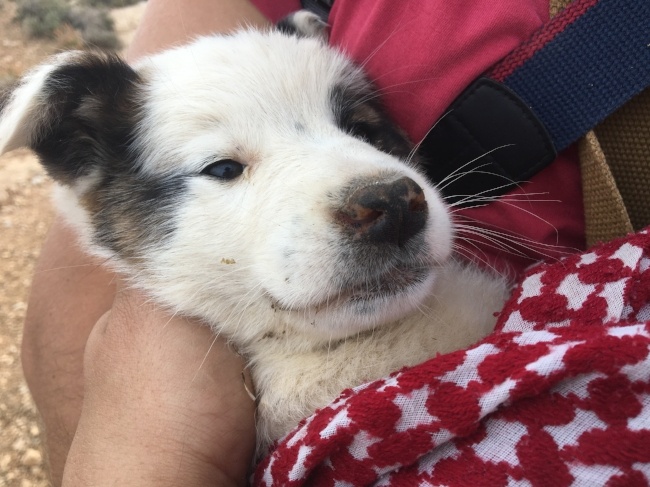
“Surprise! Nebo’s a girl!” I said, then handed her back to Muna and went in to see the church for myself. When it was time to hike again, Ziatuna took the puppy and we began the tricky descent from Mount Nebo. For hours we tiptoed sideways down the mountainside, and I was amazed at how the trail was becoming a little less innocent, sometimes even precarious, as a wrong detour left or right would lead to impossible cliffs.
Once we had reached flat land, we stopped for lunch at a small spring, where older man and his wife had brought their herd of goats to drink. Ziatuna asked for some goat milk and without hesitation, the kind woman pulled out one of the goat’s udders and filled up a whole cup of creamy, warm, foamy goat milk.
Nebo sniffed at first, then dipped a tongue and began lapping away, even sticking her snout all the way down to the bottom of the cup, licking it dry. In that moment, I saw the dog change color—her fur became whiter and fluffier, and she became more alive.
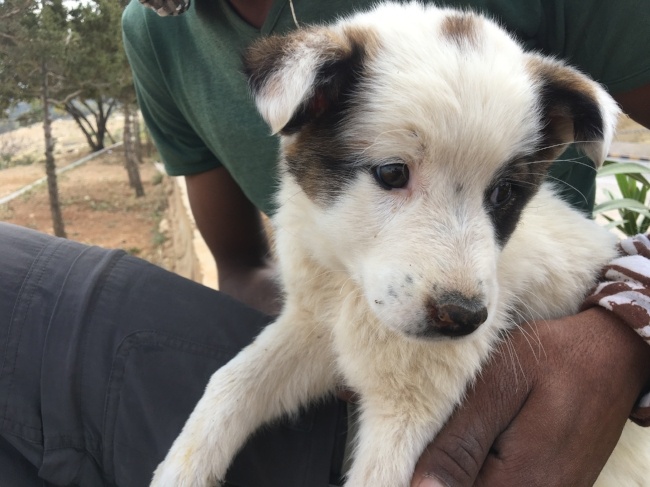
The Search for a Vet
Still, Nebo was not healthy. She had bad diarrhea and was still dangerously malnourished. I began to notice other things, too—the continued fussing, the bubbles gurgling up out of her mouth, and a few brief seizures where she attacked my kuffiyeh with her teeth. As I hiked with her, we began to worry about more serious problems—parvo or rabies. By now, the light was changing and Nebo was dead asleep—at times I worried that she was in fact, already dead, as her tiny head jostled along with the movement of my own feet, with her stiff paws sticking out. Each time I assumed we had lost her, I dropped my head and blew gently, watching her eyes move, showing a bright gleam of hope from the starved, sick puppy. Each time, I felt relieved that she was still alive.
Social media and many phone calls saved the day, so that by the time we reached the end of the day’s hike, we had found a humane no-kill shelter willing to take her. As much as we wanted to keep Nebo on the trail with us, she required a veterinary and the kind of care we could not offer. That night, in the dark, near the campfire, we shared our chicken dinner with Nebo, who happily gobbled up the meat and instantly turned less whiny. Then, I wistfully handed over Nebo to our friend Bashir, who drove Nebo all the way back to Amman and checked her into the Humane Center for Animal Welfare (www.hcaw-jordan.org), where she could get the kind of immediate care she needed.
For the next few days, we called, texted, and left messages with the shelter, begging for news from Nebo. Eventually we found out: Nebo was negative for parvovirus and any other serious illness, but was merely malnourished, weak, and dehydrated. The vet was keeping her a bit longer to feed her and let her regain her strength before putting her up for adoption by a forever family.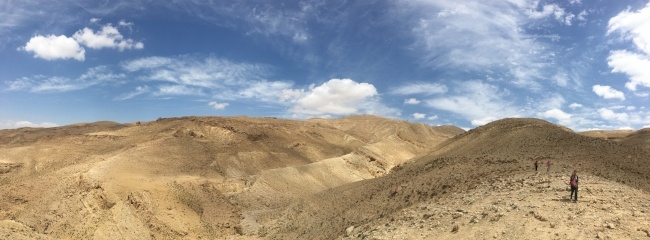
I was glad to hear it—for Nebo’s sake—though as silly as it sounds, I still miss that dog. She was part of the Jordan Trail, if only for a day, and we had carried her—lifted her up from her lonely little place on the plateau and traveled some 20 km with her, up and over Nebo. We had hugged her, cleaned her, fed her, and loved her—and then, as we are forced to do with so many of the other hikers we meet, we had to say goodbye too quickly.
So this is my goodbye to Nebo, because she is a small piece of my Jordan I can never forget—how among the mighty mountains of ancient prophets, the elaborate stone churches, and even the Baptism Site of Jesus Christ, there was also a tiny little puppy who just wanted to be held.
Follow my personal adventure on social media with #AndrewWalksJordan and #ThruJT and on the Andrew Walks Jordan homepage.

